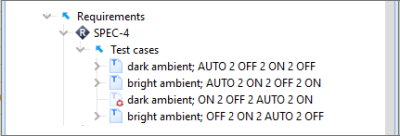Usage
The Usage view shows where a selected element is used, for example in which test cases a variant is used and to which requirements it is linked. To display the usage of an element, right-click on the element and select Show Usage. To update the displayed information, click ![]() . The usage information of the selected element will be displayed until you right-click on another element and select Show Usage. Usage information can be displayed for the following elements:
. The usage information of the selected element will be displayed until you right-click on another element and select Show Usage. Usage information can be displayed for the following elements:
- assesslet
- execution configuration
- mapping
- platform configuration
- requirement
- signal (channel, parameter, constant, measurement, assessment)
- test case
- test set
- testlet
- variant
The name of the selected element is displayed at the top of the usage tree. If the element is used in specific sections, a section heading like Test cases, Assesslets, or Requirements is displayed. Section headings are preceded by a blue arrow ![]() . Only those elements making use of the element above are listed; for example: if you have 40 requirements, and your selected element is only linked to the requirement "SPEC-13", only "SPEC-13" will be displayed.
. Only those elements making use of the element above are listed; for example: if you have 40 requirements, and your selected element is only linked to the requirement "SPEC-13", only "SPEC-13" will be displayed.
Usage view showing which elements are using variant "dark ambient; AUTO 2 OFF 2 ON 2 OFF"
In the screenshot above, the variant dark ON is used in the test case dark ambient; ON 2 OFF 2 AUTO 2 ON. The variant is linked to the requirement SPEC-4 and is explicitly selected in the Common assesslet settings of the assesslet headlight ON if switch AUTO and dark, see Common Assesslet Settings - Variants. The Usage view works recursively. Thus, by clicking on the + next to the entry in the Usage view, you will get a list of all elements using this item.
For example, by expanding SPEC-4, all elements linked to it are displayed. When the usage of an element is already displayed, the element's name is dimmed and shows a recycle symbol like ![]() ; this element cannot be expanded once more.
; this element cannot be expanded once more.
Usage view showing the usage of "SPEC-4"
|
|
refresh (shortcut F5); click if the usage might have been changed |
|
|
section heading |
|
|
element has already been expanded at an another place |
Filter/search settings
The Usage view has its own filter/search field. The search always starts from the top or from the selected expanded element. Only the names of expanded items can be searched.
Filter/search field
By default, the search is set to string search. To use regular expressions, select the Regular Expressions checkbox. For example, the term ^L.*(g|y)$ will search n element/object that begins with an L and ends with an g or an y. The search is not case-sensitive, see Common Regular Expressions.
Filter
Only the elements that contain the search phrase are displayed. The filter is only applied to the names of items that are or have been expanded.
Filtered usage



